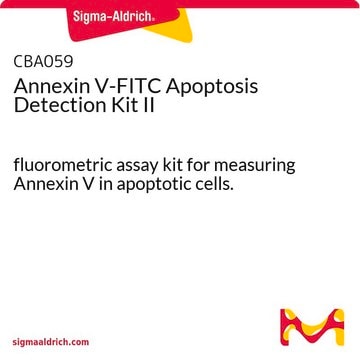APOBRDU
Flow Cytometry Kit for Apoptosis
About This Item
Produits recommandés
Utilisation
sufficient for 60 cell suspensions
Conditionnement
pkg of 1 kit
Technique(s)
flow cytometry: suitable
Application(s)
cell analysis
detection
Méthode de détection
fluorometric
Conditions d'expédition
wet ice
Température de stockage
2-8°C
Application
Caractéristiques et avantages
Conditionnement
Principe
Composants de kit seuls
- Br-dUTP 480 μL
- Fluorescein PRB-1 antibody 300 μL
- Negative control cells 5 mL
- PI/RNase staining buffer 30 mL
- Positive control cells 5 mL
- Reaction buffer .6 mL
- Rinsing buffer 120 mL
- Terminal deoxynucleotidyl transferase (TdT) 45 μL
- Wash buffer 120 mL
Mention d'avertissement
Danger
Mentions de danger
Conseils de prudence
Classification des risques
Carc. 1B - Eye Irrit. 2 - Flam. Liq. 2 - Resp. Sens. 1 - Skin Sens. 1
Code de la classe de stockage
3 - Flammable liquids
Point d'éclair (°F)
55.4 °F
Point d'éclair (°C)
13 °C
Certificats d'analyse (COA)
Recherchez un Certificats d'analyse (COA) en saisissant le numéro de lot du produit. Les numéros de lot figurent sur l'étiquette du produit après les mots "Lot" ou "Batch".
Déjà en possession de ce produit ?
Retrouvez la documentation relative aux produits que vous avez récemment achetés dans la Bibliothèque de documents.
Les clients ont également consulté
Articles
Tests sur cellules pour l'étude de la prolifération (BrdU, MTT, WST1), de la viabilité et de la toxicité cellulaires pour la recherche sur le cancer, la recherche en neurosciences et la recherche sur cellules souches.
Cell based assays for cell proliferation (BrdU, MTT, WST1), cell viability and cytotoxicity experiments for applications in cancer, neuroscience and stem cell research.
Cell based assays for cell proliferation (BrdU, MTT, WST1), cell viability and cytotoxicity experiments for applications in cancer, neuroscience and stem cell research.
Cell based assays for cell proliferation (BrdU, MTT, WST1), cell viability and cytotoxicity experiments for applications in cancer, neuroscience and stem cell research.
Notre équipe de scientifiques dispose d'une expérience dans tous les secteurs de la recherche, notamment en sciences de la vie, science des matériaux, synthèse chimique, chromatographie, analyse et dans de nombreux autres domaines..
Contacter notre Service technique










